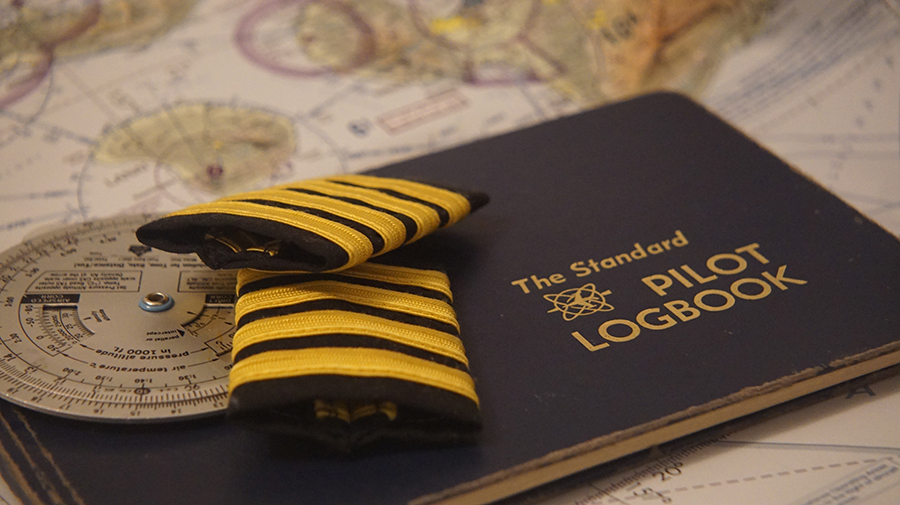-
Key Takeaways
-
Understanding the Effects of Crosswind on Taxiing
-
Fundamental Principles of Crosswind Taxi Techniques
- “Climb Into”
- “Dive Away”
- The Main Principle
-
Control Inputs for Different Wind Conditions
- Taxiing With a Headwind
- Taxiing With a Tailwind
- Taxiing in a Quartering Headwind
- Taxiing in a Quartering Tailwind
-
Practical Application of Crosswind Taxi Techniques
- Scenario 1: Turning from One Taxiway to Another (Wind Shifting)
- Scenario 2: Gusty Conditions
- Scenario 3: Takeoff & Landing
- Continuous Monitoring & Awareness
-
Common Mistakes and How to Avoid Them
- Mixing Up Control Inputs
- Not Adjusting During Turns
- Neglecting Wind Strength
- How to Avoid These Mistakes
-
Tips for Effective Crosswind Taxiing
- Situational Awareness
- Best Taxiing Techniques
- Continuous Practice
-
Conclusion
Have you ever felt your aircraft veer off course during taxi, and you’re forced to fight the controls? Oftentimes, that sudden pull isn’t just from sloppy steering, but actually the work of crosswinds.
Wind has a powerful influence even on the ground, especially on lighter general aviation aircraft with more surface area exposed. It can lift a wing, push your tail, or turn you into the wind at the worst moment.
That’s why mastering crosswind taxi techniques is such an essential skill. Let’s talk about the right control techniques so that you can taxi safely no matter the conditions.
Key Takeaways
- Crosswinds can lift wings, push the tail, and cause weathervaning during taxi operations.
- Hold aileron into the wind and elevator slightly back in a quartering headwind.
- In a quartering tailwind, hold the aileron away from the wind and move the elevator forward.
- Taxi slowly, monitor windsocks, use proper power, and practice correct inputs consistently.
Understanding the Effects of Crosswind on Taxiing
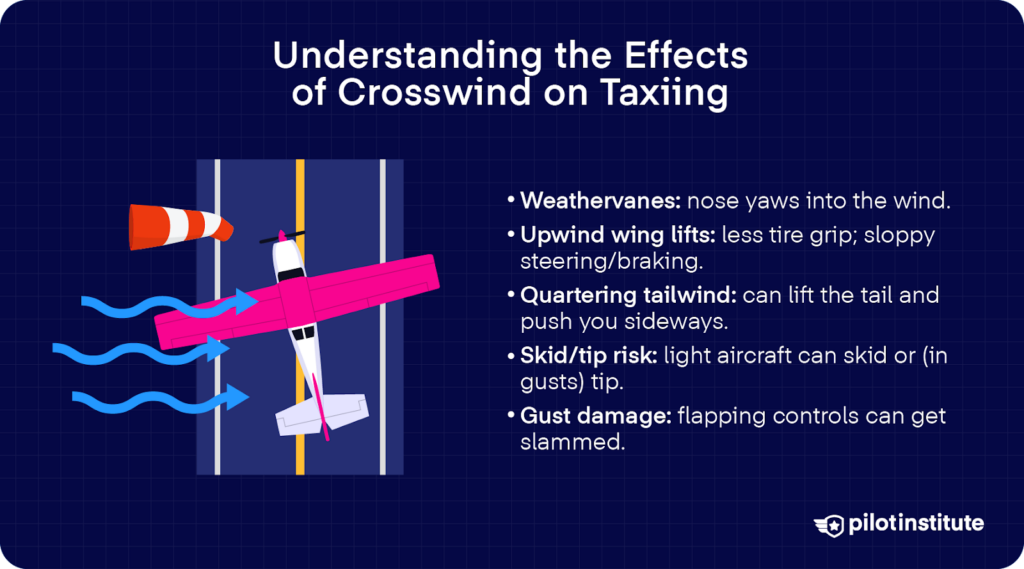
The wind can have a powerful impact on how your aircraft behaves, and yes, even on the ground. So, what effects should you watch out for?
Weathervaning & Lifting Effect
When you’re taxiing in a crosswind, one of the first things you notice is your airplane’s tendency to weathervane.
As the name suggests, the vertical tail would act like a weather vane, and your nose seems to want to swing into the wind in response. This tendency can quickly pull you off your intended path if you’re not actively correcting with rudder or brakes.
Another challenge comes from the lifting effect of the wind. Remember that your aircraft is optimized to produce lift, even when you don’t want to.
A strong crosswind gust can raise the upwind wing or even the tail, especially in lighter aircraft. If you don’t stay ahead of it, the wind can cause you to lose steering control or, in extreme cases, even tip your airplane.
Aircraft Type Consideration
Not every aircraft reacts the same way to crosswinds.
Lighter airplanes, with their smaller mass and relatively large surface area, are more easily pushed around by gusts. Heavier aircraft have more inertia, which makes them less sensitive but not immune to crosswind effects.
Do you fly tailwheel aircraft? If so, then you need to pay extra attention when taxiing in a crosswind.
Because of their landing gear configuration and center of gravity, tailwheel aircraft are prone to ground loops and tipping. They also experience an exaggerated weathervaning tendency, especially when taxiing with a direct crosswind.
This is where the proper use of ailerons and the elevator comes in. As long as you hold the correct control positions, you should be able to counteract the wind’s attempt to lift a wing or push the nose around.
Fundamental Principles of Crosswind Taxi Techniques
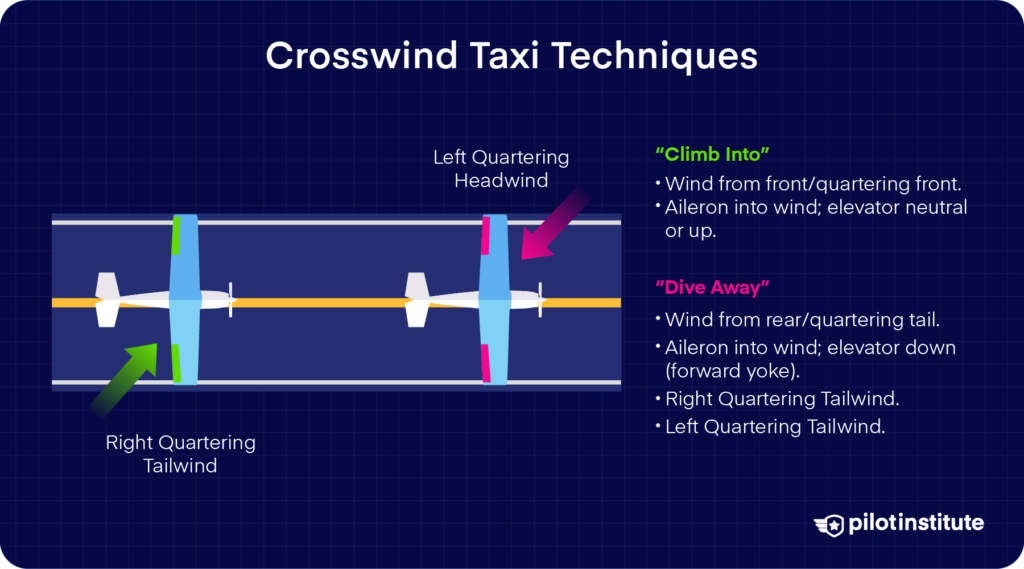
Pilots tend to mix up their controls during crosswind taxiing, but with a handy mnemonic, you won’t be one of them. Just remember: Climb into a headwind, dive away from a tailwind.
It’s short, catchy, and helps you place the ailerons and elevator. But how does it work in practice? Let’s split it into two:
“Climb Into”
“Climb into” a headwind is all about when the wind is coming from the front or from a front-side angle (a quartering headwind). You turn your ailerons into the wind. At the same time, keep the elevators neutral or pull back on the control yoke (elevator up).
That helps keep the upwind wing from lifting and the tail from being shoved down or lifted by slipstream or gusts.
“Dive Away”
On the other hand, when the wind is coming from behind or from a rear-side angle (quartering tailwind), you “Dive away.”
Push the yoke forward (elevator down) and again use the ailerons to tilt the upwind wing downward. This prevents the wind from getting under the tail or lifting a wing.
The Main Principle
These inputs vary based on where the wind is coming from: front, back, left side, or right side. The side the wind blows from determines which wing is up or down and whether the elevator needs to be forward or back.
Use the mnemonic to adjust these control inputs intuitively. When the wind shifts, you shift your controls. Over time, this will feel like second nature. Just keep practicing the technique.
Control Inputs for Different Wind Conditions
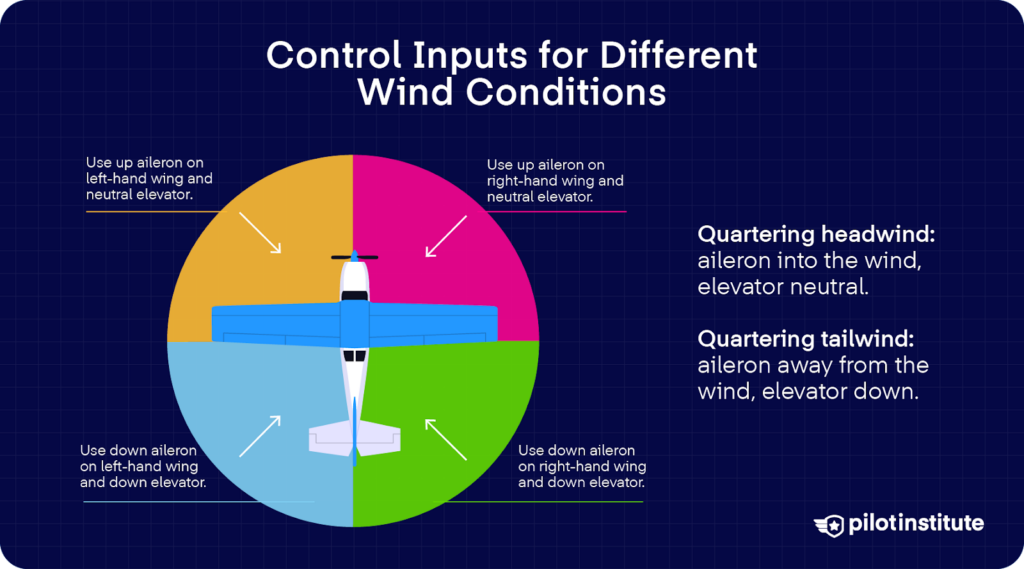
When you taxi in windy conditions, the way you set your ailerons and elevator makes a big difference in keeping the aircraft steady.
The FAA gives us clear guidance on positioning your controls depending on whether the wind is hitting you.
Taxiing With a Headwind
If the wind is blowing directly from the front, you should stay in control of the elevator and firmly hold the tail down. If you’re in a nosewheel airplane, keep the elevator in a neutral position.
For tailwheel types, it should be held in a full aft position. However, if the headwind gets very strong, you can hold the elevator closer to neutral.
These inputs combine to keep all wheels in contact with the ground and give you steady directional control.
Taxiing With a Tailwind
Now imagine the wind pressing straight from behind. Here, the technique flips.
You turn the yoke away from the wind, which lowers the upwind aileron. Doing this keeps the wing from catching lift where you don’t want it.
You also push the yoke forward to bring the elevator down. That forward pressure prevents the tail from rising. If you fly a tailwheel airplane, this is especially important since a nose-over could easily end up in a propeller strike.
But while pushing the stick forward is vital in strong tailwinds, it’s not always appropriate in lighter winds. Even in smaller aircraft, the propeller wash usually creates enough airflow over the tail to cancel out a light tailwind, and you’re left with a net headwind instead.
So, what’s the best move? Pulling the stick back often gives you better directional control. If you’re unsure, feel out the wind as you taxi and position the elevator where it helps the most.
You usually won’t need much engine power once the airplane starts rolling because the wind helps push you along. To keep from overheating the brakes and to stay in control, use as little power as possible.
Instead of riding the brakes the whole time, tap them only when you need to slow down. Except for making sharp turns at very low speed, always bring the throttle back to idle before applying the brakes.
Taxiing in a Quartering Headwind
When the wind comes from ahead but off to the side, your airplane is at risk of both wing lift and tail movement.
How can you counter this? Turn the ailerons into the wind. This raises the upwind aileron, which spoils lift on that wing and prevents gusts from lifting it.
At the same time, you hold the elevator neutral for tricycle-gear airplanes or slightly back for tailwheel aircraft to keep the tail steady. However, for tailwheel airplanes, some quartering headwinds are so strong that they could lift a wing. In this case, you can hold the elevator closer to neutral.
Either way, the goal is the same: stop the upwind wing from lifting and keep the tail under control.
Taxiing in a Quartering Tailwind
A quartering tailwind is often the trickiest situation, because the wind can sneak under both the wing and the tail. How can you resist danger?
Turn the yoke away from the upwind wing to remove lift from that wing. At the same time, you push the yoke forward to hold the elevator down.
This downward pressure on the tail improves steering while keeping the wind from lifting the tail and driving the propeller into the ground.
Practical Application of Crosswind Taxi Techniques
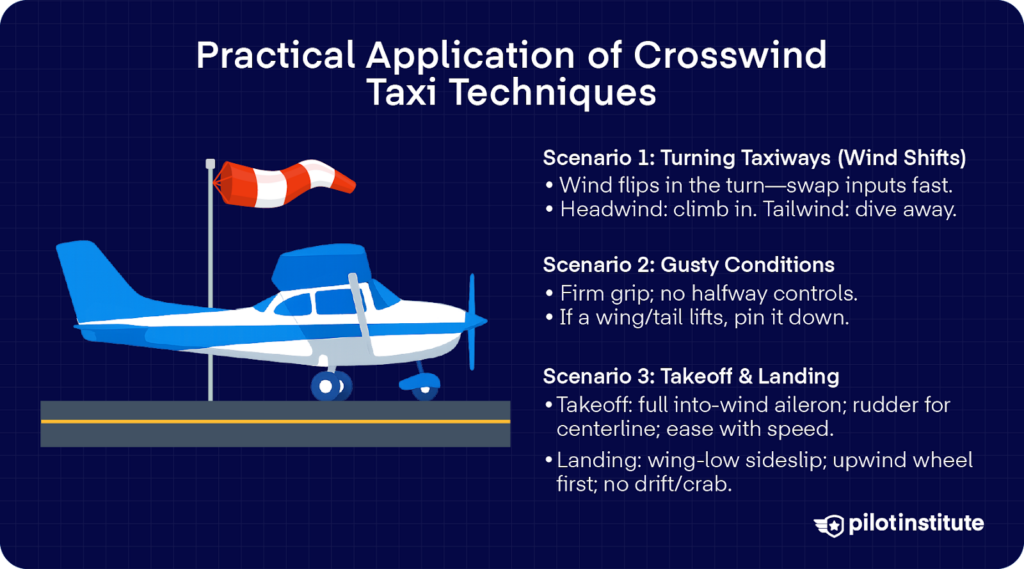
These techniques are easy to follow if you’re just standing still on the ramp. But in a real flight, you’ll have to get moving eventually.
Putting control-input theory into practice is where you really see the difference.
Scenario 1: Turning from One Taxiway to Another (Wind Shifting)
Let’s say you’re taxiing down a taxiway with a crosswind coming from your front-left. Everything feels steady. Then you turn right to another taxiway.
As you make that turn, what was a quartering headwind becomes a quartering tailwind. What will be your next move?
When this happens, you must adjust your control surfaces accordingly. Remember, “Climb into a headwind, dive away from a tailwind.”
Initially, you were climbing into the quartering headwind. If you followed procedures, you should have started with the left aileron up and the yoke slightly aft or neutral.
As you begin turning, use the rudder pedals to steer the nosewheel. After reaching full pedal deflection, you can add brakes if you need a tighter turn.
The aileron that was into the wind should slowly “dive away” from it as you make the turn. At the same time, gradually apply forward pressure on the yoke to move the elevators downward.
Don’t wait. As best as you can, anticipate shifts and stay coordinated when turning. Keep one eye on windsocks, wind flags, smoke, or anything that shows wind direction.
Every time your heading changes, retrace “Where is the wind relative to me?” and adjust.
Scenario 2: Gusty Conditions
All that should be manageable enough, but imagine taxiing in gusty winds. The wind speed is changing constantly, and gusts hit the wing or tail unexpectedly. What should you do then?
In those moments you must stay ready. That means keeping a firm grip on the control yoke. It means not being halfway between control settings.
If a gust threatens to lift the upwind wing or tail, move the aileron or elevator into the correct position so that the wind doesn’t get under surfaces you want grounded.
Also, when gusts strike, your reflexes matter. A sudden gust might push the nose, lift a wing, or shift the tail. If you are light on control inputs or not expecting it, things can get worse fast.
So even at slow taxi speeds, maintain control positions appropriate to wind conditions and be ready to change them instantly.
Scenario 3: Takeoff & Landing
You’re finally cleared for takeoff, but that pesky crosswind is still blowing. How will you respond?
At the start of the takeoff roll, apply full aileron into the wind and maintain it until the ailerons become effective, then decrease as needed while keeping some into-wind aileron through liftoff. This helps keep your aircraft firmly on the runway.
As you lift off, expect the weathervaning effect to swing the nose into the wind.”
As you accelerate and lift off, expect a weathervaning tendency on the ground and use rudder to keep the longitudinal axis aligned with the runway; once airborne, establish appropriate drift correction.
Once airborne, use coordinated rudder and aileron inputs to stay balanced, hold the wings level, and maintain a departure path aligned with the runway centerline. You should keep correcting for the crosswind component even in the air.
Then comes the time for you to approach and land. In a crosswind, there will be a couple of things to consider.
Sometimes you’ll need to correct for wind drift on final approach by crabbing into the wind. But if you try to round out or touch down while still drifting or crabbing, the airplane will hit the runway moving sideways.
This puts heavy side loads on the landing gear and, if severe, can even cause damage.
So, what’s the best way to prevent drift? The wing-low method.
To prevent drift at touchdown, use the wing-low (sideslip) method: lower the upwind wing and hold opposite rudder to keep the nose aligned with the runway; touch down on the upwind main wheel first.
If you don’t correct for drift, the tires resist the sideways motion as soon as they touch the ground. Side-skipping and side-loads can induce bounces and impose severe stresses on the gear; use proper crosswind correction to avoid drift at touchdown
Touching down while still drifting or in a crab imposes severe side loads on the landing gear; remove the crab or transition to a sideslip before touchdown
Continuous Monitoring & Awareness
Have you noticed the common theme in our scenarios? It’s constant awareness. Wind doesn’t stay the same just because you started taxiing.
It shifts, gusts, or changes relative angles as you turn. So check windsocks, flags, and wind indicator boards often.
Watch visual cues: smoke, grass, dust, airplanes in movement, flags. Also, use what the airport gives you: ATIS or AWOS/ASOS, tower or ground calls, notices.
If you see a change, change your inputs. Recheck whether your aileron is still into or away from the wind, whether your elevator should be neutral, up, or down.
Common Mistakes and How to Avoid Them
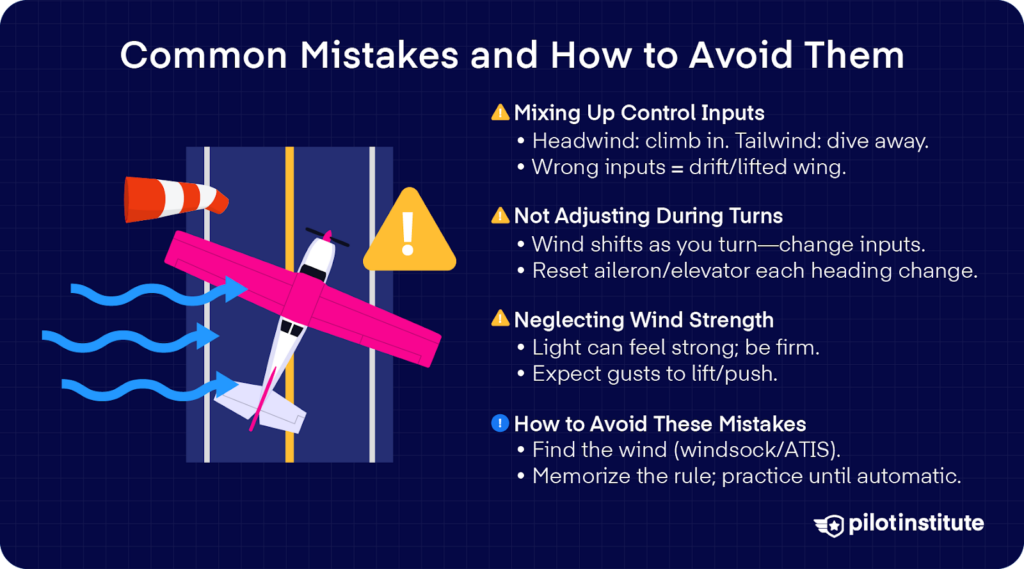
Even seasoned pilots can slip up when taxiing in crosswinds. Recognizing where things often go wrong helps you avoid them.
Mixing Up Control Inputs
One frequent error is using incorrect control inputs. You might mix up which aileron goes up or down depending on whether the wind is ahead or behind.
That confusion makes your control less effective, and the aircraft tends to drift or lift a wing when you least want it to.
Not Adjusting During Turns
Another common mistake occurs during turns. When your heading changes, say, when you turn from one taxiway to another, remember that the relative wind direction changes, too.
If you keep the control positions as though nothing changed, the aircraft may suddenly be in a different wind condition without you adjusting. That’s when loss of control becomes more likely.
Neglecting Wind Strength
It’s easy to underestimate or even neglect the wind strength entirely, especially on calm-looking days. But don’t let light breezes fool you.
You’ll have to adjust your control for stronger wings. If you don’t respond accordingly in strong winds, the aircraft can drift, lift a wing, or even tip.
Does this mean you should be aggressive with your controls? Not always.
Remember that for strong headwinds, too much back pressure on the yoke can end up lifting the wings. For light tailwinds, the propeller wash could create a net headwind over the tail. In a tailwheel airplane, pulling the stick back often provides better directional control in this specific situation.
If you are unsure, feel out the wind as you taxi and position the elevator where it helps the most. In a tricycle gear airplane, the standard procedure for a tailwind is to keep the yoke forward.
But that doesn’t mean your control inputs should be relaxed, either. Gusty conditions bring surprises. A gust can hit unexpectedly, lifting the wing or tail, pushing the nose. If your controls are not set firmly, you may be caught off-guard, and it might be too late once you realize what’s going on.
How to Avoid These Mistakes
You can reduce your chances of errors by building habits that respond well to wind changes. First, always find the wind before taxiing.
Where can you get wind information? Look at the windsock, flags, smoke, and even moving ground objects. Confirm which direction the wind is coming from before you move.
Tune into weather and aerodrome information frequencies, or request from tower or ground control.
Commit our mnemonic to memory. “Climb into the wind, dive away from the wind.” That phrase helps you remember how to position your ailerons and elevator quickly without having to think through each detail.
Stay vigilant during taxiing. Wind doesn’t stay constant. Turnings, gusts, or wind shifts mean you may need to adjust aileron or elevator positions mid-taxi. Keep your grip firm on controls and stay ready to respond to the wind.
But what really makes a huge difference is consistent practice.
In training, try changing control positions as you taxi and as wind shifts. Do this even in a mild wind. Over time, your hands will start moving correctly without needing to think hard.
Tips for Effective Crosswind Taxiing
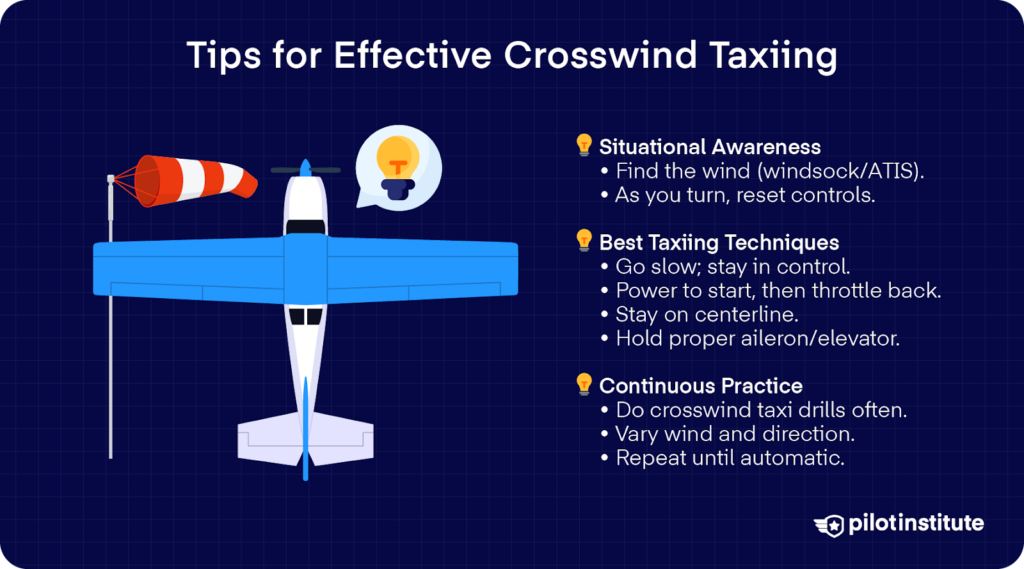
Situational Awareness
Situational awareness is your first line of defense when taxiing in crosswinds. Before you move, make sure you know how the wind is behaving around you.
Look for windsocks, flags, smoke, or any visual cues to see which way the wind is blowing. Listen to airport-weather reports if available.
As you change direction during taxiing, the wind’s angle relative to your aircraft changes too. Keep up with those shifts so you can adjust the control surfaces before the wind causes trouble.
Best Taxiing Techniques
Always taxi at a safe, controlled speed. If you move too fast, you’ll have less time to react to sudden gusts or changes in wind direction.
Keeping the speed under control helps you stay ahead of the airplane. You’ll get to spot hazards early and stop or turn when needed, without having to lean too heavily on the brakes.
Using the right power setting is another best practice. You’ll often need more power to start moving or to initiate a turn.
But once the aircraft is rolling, reduce throttle so you don’t end up riding the brakes or speeding up uncontrollably. Remember that taxiing with a power setting that forces you to use the brakes continually is a common error.
You’ve been taught to keep your aircraft on the taxiway centerline, but why does it matter? Well, it gives you extra margin from obstacles and helps preserve directional stability.
When your fuselage is centered, you reduce the chance of being pushed into signage or structures by the wind.
Particularly at airports with yellow centerline stripes, visually aligning the fuselage with that stripe helps keep everything well controlled.
Even in light winds, holding proper control surface positions builds strong habits. Correct use of aileron and elevator settings in a crosswind prepares you to react properly, especially when gusts or stronger winds show up.
Continuous Practice
Finally, continuous practice is essential to becoming proficient. How can you train your taxiing skills?
Incorporate crosswind taxiing into your regular training sessions. Try varying wind directions and strengths when possible so you see how the aircraft responds in different conditions.
Repetition helps these control inputs become instinctive rather than having to think through step by step.
Conclusion
Whichever airport you find yourself in, the procedure will always be the same. It’ll all be about protecting your aircraft and keeping your every response under control.
Proper use of ailerons and the elevator prevents sudden lifts or dangerous tipping, especially in gusty or shifting winds. Staying alert and applying the right corrections as the wind changes builds confidence and consistency.
In the end, strong crosswind taxi skills don’t just make taxiing safer. They strengthen your overall airmanship. After all, a safe flight starts on the ground.

